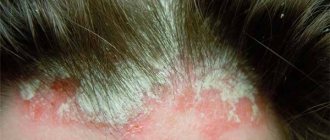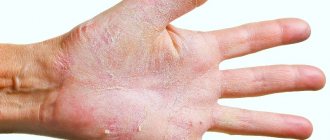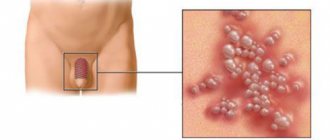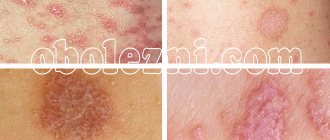The herpes virus, which managed to infect 95% of people on Earth, but managed to remain invulnerable and unharmed, has many mechanisms of both protection and incredibly rapid spread. It is largely thanks to this that he managed to become a scourge for people, regardless of their age, gender and skin color.
Although, it would seem, the herpes virus “didn’t come up with anything radically new in the methods of transmission”...
What is herpes
Herpes infection is a complex of infectious diseases that are provoked by the increased activity of several types of viruses. Among these are labial herpes (type 1), genital herpes (type 2), herpes zoster (varicella zoster virus), cytomegalovirus infection (type 5 virus). It is impossible to completely destroy the infectious agent, but it can be healed for a long time. If herpetic rashes appear, it is necessary to promptly consult a specialist, undergo diagnostics and begin conservative treatment.
Length of incubation period
To make a diagnosis, it is important to know how long it takes for signs of infection to appear after a pathogen enters the body. Different types of herpes viruses have different incubation periods. The shortest asymptomatic phase is the herpes labialis virus, the longest is the cytomegalovirus infection.
- Type 1 - with labial herpes, the incubation period usually does not exceed 2-7 days; the introduction of the pathogen into the tissue can manifest itself as mild malaise, night chills, and a slight increase in temperature (up to 37-37.2 degrees).
- Type 2 - the incubation period for the genital form of the disease lasts 1-20 days, more often for 10-14 days in women and 7-10 days in men; in the prodromal phase, symptoms of intoxication are not typical.
- Type 3 – the incubation period for chickenpox is 2-3 weeks; for herpes zoster, the asymptomatic phase lasts 2-7 days.
- Type 4 - infectious mononucleosis is characterized by a long incubation period - 5-40 days, during which patients may feel general malaise, lethargy, and drowsiness.
- Type 5 - mononucleosis-like syndrome has the longest incubation period, which is 40-60 days.
- Type 6 - the incubation period of childhood exanthema lasts 5-15 days; in case of relapse, the infection can manifest itself in the form of pityriasis rosea, chronic fatigue syndrome, multiple sclerosis.
The duration of the asymptomatic phase of infection depends on the level of immunity. With a significant suppression of the body's defenses, a short incubation period is characteristic.
The herpes virus has the longest incubation period, reaching up to 2 months from the moment it enters the body.
Symptoms
As a result of the large-scale spread of infection, the quality of life of the clinical patient decreases, and differential diagnosis is necessary to make a final diagnosis. Only detailed blood tests can determine the type of virus associated with HSV infection. In any case, the characteristic illness is contagious, so the patient must promptly respond to the following changes in general well-being:
- increased body temperature;
- discomfort with itching and burning of the pathological focus;
- decreased immune defense of the body;
- clinical pictures of the appearance of bubbles;
- increased secretion of saliva (with laryngeal herpes virus);
- hyperemia of pathological foci with skin rash (appears on the skin, mucous membranes);
- severe signs of a cold.
Foci of pathology become covered with a small rash and begin to hurt from every touch. Over time, the formed blisters begin to burst, and wounds appear in their place, which take a long time to heal. After infection, the affected mucous membranes and skin change their structure, and noticeable scars may remain on the surface.
Is herpes infection transmitted?
The disease caused by herpes simplex is contagious, so it is important to avoid contact with carriers of the pathogenic infection. The process of infection of the fetus is intrauterine - through the general blood flow from mother to child. It is difficult to get rid of this kind of congenital diseases of an infectious nature, and final recovery is not at all possible. Having inherited the virus, a child automatically falls into a risk group - the number of relapses increases under the influence of pathogenic factors. So herpes is contagious and dangerous for people at any age.
Bottom line
How does the herpes virus spread? The answer is simple: it has many transmission routes that every person encounters every day.
Since in most cases, herpes attacks a person in childhood, you should carefully monitor the maintenance of strong immunity in the child.
Adults are also susceptible to infection, but mostly it occurs repeatedly and has a milder form. However, it is better to prevent a relapse by using the prevention tips given above. In addition, thanks to them you can reduce the spread of the virus if you are a carrier.
How is it transmitted?
There is a generally accepted opinion that herpes is transmitted by airborne droplets and nothing else. This is an erroneous reasoning, since there are several ways of transmitting a pathogenic infection, and all of them contribute to the risk of infection of the body against the background of a weakened immune system, long-term antibiotic therapy and exposure to other provoking factors. Here's how herpes infection can be transmitted:
- Contact-household way. If you kiss a patient with herpes on the lip, it is possible that a few days later a similar wound will appear on the lip of a once healthy person. It is not recommended to use household items and personal hygiene products for the patient, since in this case relapses of the disease cannot be avoided.
- The direct way. In this case, we are talking about direct contact with the patient, for example, through touching, communicating, or being in the same area. A patient with primary infection does not look like the infected person, and he himself is not aware of the presence of the virus in the body.
- Sexually. Cytomegalovirus is transmitted in this way, which in the future requires timely treatment of both sexual partners. To avoid extremely unwanted infection, it is necessary to use condoms or other methods of barrier contraception, especially during casual sexual contacts.
- In utero. This method of infection is described above, so women need to approach the issue of family planning with special sensitivity. Otherwise, pathogenic flora affects the health of newborns almost from the first days of life.
How is herpes on the lips transmitted?
When a small blister appears on the surface of the lip, this is the first sign of progressive herpes. If you kiss a person with such a symptom or use his cup or spoon, after a few days it is possible that he will become infected again with similar symptoms. So herpes on the lips is transmitted through a kiss, through contact and household contact; at the same time, at the early stage of the disease it is invisible, but over time a wound appears, which begins to hurt very much.
If the virus appears on the lips, it is important to understand that such a pathogenic infection is transmitted by sneezing and coughing, talking, or oral sex with an infected patient. As soon as the microbe penetrates the mucous membrane, a rapid reproduction process begins, which cannot be stopped without antiviral drugs. It is difficult to put up with these lesions, since the focus of the pathology hurts, swells, turns red, itches and itches. Signs of the disease should not be ignored, otherwise the number of relapses will increase sharply.
Through a kiss
Since the characteristic disease is accompanied by the formation of wounds on the lip or oral mucosa, a healthy person has every chance of not contracting a herpetic infection. Since pathogenic flora is rapidly transmitted through kisses, you should not contact the patient so intimately. Herpes is transmitted through saliva through kissing, and patients at risk should not forget about this. Otherwise, you will need to take a course of antiviral drugs, an integrated approach to the health problem.
Is a patient dangerous if there are no rashes on his lips?
If herpes is not accompanied by visible symptoms, this does not mean that a healthy person cannot become infected. Even if the patient does not have characteristic rashes in the mouth or lips, and the saliva contains herpes, infection cannot be avoided. Otherwise, everything depends on the strength of the immune system, as soon as the first symptoms of the disease remind you of themselves. Herpetic infection is dangerous even in the so-called “dormant state”, since it activates its action under the influence of pathogenic factors. So you should be especially vigilant when communicating with an infected person.
The appearance of a rash on the back of a child.
For children, the spread of red rashes can cause not only the negative impact of the virus, but also the diagnosis of herpes type 6. Typically, in such cases, children exhibit the following symptoms of herpes zoster:
- High body temperature for several days in a row.
- Then rashes appear on the back.
- Then on other parts of the body.
- Loss of appetite.
- Frequent whims and tears.
Such rashes may disappear as suddenly as they appeared. This usually happens from 3 hours to a couple of days. In such cases, herpes on the back of a child may not be called true rubella or roseola infantile. It was not possible to find out why such symptoms occur. But there is an assumption that this disease most often affects children with a weak immune system, with meningitis, pneumonia, heart disease and hepatitis.
Important! To treat herpes, our readers successfully use Elena Makarenko’s method. Read more >>>
Even when the symptoms that appear do not confirm the presence, this may be the first signal that a serious malfunction has occurred in the child’s body. Therefore, it is very important to choose the right medication treatment.
How is genital herpes transmitted?
One of the ways of transmitting herpes from a sick organism to a healthy one is sexual. To prevent infection of the mucous membrane, it is recommended to use condoms, especially if there is no clear confidence in the sexual partner. HSV types 1, 2 and 5 are transmitted sexually. The most common routes of transmission of pathogenic infection are presented below:
- A pathogenic microbe enters the body not only as a result of sexual intercourse with a virus carrier, but also after oral sex. In this case, infection occurs with genital herpes, which is transmitted from the mouth of an infected person to the genitals of a healthy partner with subsequent penetration into the systemic bloodstream.
- It is possible that the pathogenic HSV-2 virus can be transmitted during anal sex from a patient to a healthy sexual partner. If a person knows about his disease, he should refrain from unprotected sexual intercourse, even if it is anal sex (the risk of infection is still high).
- Contact between skins also transmits a dangerous virus, especially if abrasions, cracks, cuts and other mechanical damage predominate on the surface of the dermis. In this case, you can become infected through skin-to-skin contact, and the patient does not even need to kiss a healthy person.
Sexual infection
When it comes to genital herpes, the main route of transmission of such a pathogenic infection is sexual contact. An infected person may not be aware of the presence of pathogenic flora in his body for a long time, and therefore unknowingly becomes a potential threat to all people around him and sexual partners. Therefore, doctors recommend being selective about your sexual relationships, always using barrier contraception methods, and undergoing a full examination of both sexual partners in advance.
Household method
This method of transmitting herpes in medicine is the most common, and it covers all age categories of patients. Adults and children can become infected in this way through direct contact with contaminated household items. For example, a herpes infection is transmitted through the use of shared utensils, household items and personal hygiene products. The first symptoms of the disease do not appear immediately; the disease can prevail in a latent form for several years. In any case, in order to avoid infection, it is necessary to follow basic rules of personal hygiene.
Separately, it is worth informing about children who, already in the first year of life, can become infected by licking non-sterile objects. To prevent this from happening, parents should monitor the child, especially outside the walls of the house, because when surrounded by people, the risk of infection is especially high. Since the virus is transmitted in several ways, children with not yet formed or already weakened immunity are among the first to be at risk.
- Turmeric - what it is, beneficial properties and contraindications. Uses of turmeric
- Ham salad: delicious recipes
- Atherosclerosis of the vessels of the lower extremities - folk remedies and drugs. Treatment and symptoms of atherosclerosis
Treatment
Garlic acts as a good helper.
The main reasons for the occurrence of spinal herpes is a sharp decrease in immunity, this occurs in spring or autumn. Therefore, it is important to maintain immunity all year round and eat foods rich in vitamins.
People with herpes can be treated using the traditional method. There are many recipes for ointments and tinctures for wiping ulcers that relieve pain and soothe.
Doctors immediately prescribe medications to help with pain, inflammation, and to help the blisters dry out faster. For treatment, drugs are prescribed such as: Acyclovir, Famvir, Valacyclovir, Valtrex. These drugs suppress the virus, relieve pain, and prevent further development of the infection.
Severe pain is relieved by ointments that contain lidocaine, ibuprofen and acetaminophen. When the disease is roseola in children, treatment is carried out, the purpose of which is to fight the virus and reduce the temperature.
Transmission of herpes infection from mother to child
In this case, it is important to distinguish between two ways of infection with herpes - if the mother is initially infected even before pregnancy, and when the pregnant woman becomes a carrier of pathogenic flora already during pregnancy. In the first case, the threat to intrauterine development is less significant, and in the second, doctors may recommend an abortion. It is necessary to study in more detail all possible clinical pictures:
- If the microbe predominated in a woman’s life even before pregnancy, the consequences for the intrauterine development of the fetus are not so significant. However, this does not mean at all that pathology can be triggered; the main thing is to be selective about the prescribed drug therapy, follow all medical recommendations, and carry out supportive therapy.
- If HSV-1 progresses before the 20th obstetric week, the risk of infection of the fetus is minimal, and the consequences for child health are also minimal. Treatment is carried out using conservative methods in the relapse stage; in other clinical situations, the doctor recommends observational therapy. The main thing is that pathogenic flora is not transmitted to the fetus.
- If HSV-1 appears in a woman’s body in the third trimester of pregnancy, there is a 50% chance of infection of the fetus. The consequences for the child are not the most favorable, since he is born with extensive pathologies. In addition, premature onset of labor is possible.
It only remains to add that the clinical outcome for mother and child depends entirely on the type of virus that has entered the pregnant body. If it is a simple virus of the first type, there is no need to fear for the health of the expectant mother and fetus in the first trimester, but if the chickenpox virus worsens, doctors strongly recommend an abortion early in the progressing pregnancy. Otherwise, the child may be born with extensive congenital diseases and receive the status of a disabled person from the first days of life.
For whom is herpes most contagious?
Knowing how a dangerous virus is transmitted, it should be noted that there are 2 types of people in terms of susceptibility to pathogenic flora. This:
- The first category of people. When a pathogenic virus enters the body, the immune response is activated, which prevents the spread and multiplication of the pathogenic infection. There are only 5% of such people with stable immunity, but they exist and are protected from the effects of a harmful virus.
- The second category of people. That's 95%. The pathogenic virus penetrates the skin and mucous membranes, but does not meet adequate resistance from the local immune system. The disease can prevail for a long time in an asymptomatic form, but in the future it definitely progresses.
Separately, it is worth focusing attention on expectant mothers, for whom herpes is especially contagious if transmitted during pregnancy. Therefore, it is necessary to treat the period of pregnancy planning with special scrupulousness, systematically strengthen local immunity, and undergo a series of laboratory tests. Otherwise, potential complications include the need for early pregnancy termination and pathological birth in the 2nd – 3rd trimester. Pregnant women are at risk for herpes, and their treatment is significantly more complicated.
It is especially dangerous when a child with an incompletely formed immune system is sick. The symptoms are pronounced, cause internal discomfort and make the little patient nervous and irritable. If you are not treated in time with conservative methods, the number of relapses only increases, the child becomes nervous and irritable. Among the potential complications, pediatricians highlight the addition of a secondary infection.
Prevention of infection
Without detailed diagnostics of biological fluid, it is difficult to say which person is a carrier of a pathogenic virus and who was spared such an unpleasant fate. If alarming symptoms are completely absent, treating doctors still recommend taking basic preventive measures, which should become the norm of everyday life. To protect yourself from pathogenic flora and its destructive effects in the body, especially knowing how it is transmitted, you must adhere to the following preventive measures:
- It is necessary to carry out preventive vaccination using the drug Gerpevac for these purposes. Such an effective medicine helps rid 80% of all vaccinated people from the virus.
- It is necessary to regularly strengthen the immune system with natural vitamins and multivitamin complexes produced in pharmacies. In addition, moderate physical activity and cardio exercise will not be superfluous.
- It is necessary to regularly observe basic rules of personal hygiene, have a personal set of bed linen, a personal set of dishes, hygiene items, and it is important to avoid contact with already infected people in every possible way.
- During sexual intercourse (especially if you frequently change sexual partners), you must always use barrier methods of contraception. This is the best way to avoid genital herpes and its unpleasant symptoms in the life of an infected person. This is how herpes is transmitted, and the health consequences can be very unfavorable.
- If an infected person has visible symptoms of herpes on his face and body, it is advisable not to have contact with him: do not share underwear and household items, do not share your own dishes, and, especially, do not proceed to physical contact. Otherwise, after a few weeks, a once healthy person will develop similar symptoms on the body and mucous membranes.
It is important not only to know how herpes is transmitted, but also how it is dangerous for humans. For example, when entering a weakened body, the pathological process is not limited to the upper layer of the epidermis and mucous membrane. It penetrates deep into the soft tissues and can reach important bone marrow structures and nerve cells. In this case, the action of the immune system is powerless, a hidden danger to human health prevails, and the pathological process becomes irreversible.
The most dangerous carriers
You can catch the virus from anyone who carries herpes. Of course, in most cases it spreads in its active phase, but you should not relax when it goes into a dormant state. If infection occurs during a latent course of the disease, symptoms may not appear immediately, but only make themselves felt after the immune system has weakened.
When a relapse occurs and watery blisters appear on the person’s body, the contagiousness of the disease increases. This condition is characterized by the fact that it is in these pimples that a huge number of pathogenic particles accumulate, which, after the membrane ruptures, spread to all surrounding people.
If relapses occur, you should categorically forget about sexual intercourse, as well as kissing, as there will be a risk of the infection turning into a venereological disease in one or both partners.
The main carrier of herpes for a small child is the mother, who is in constant contact with him. In this case, herpes will be transmitted with a 99% probability.











